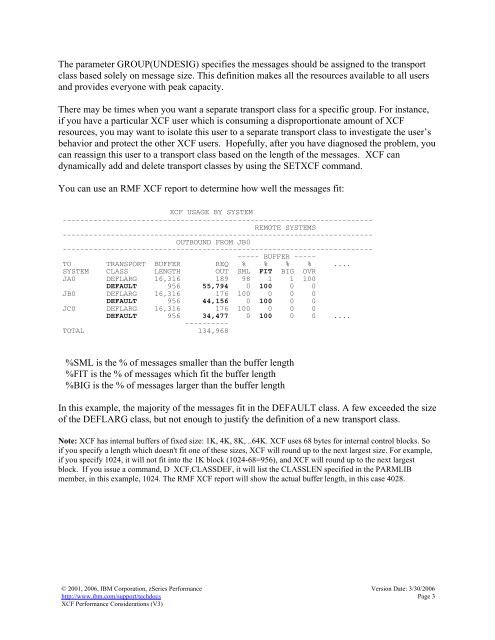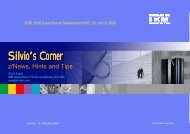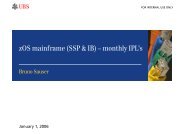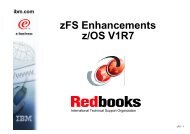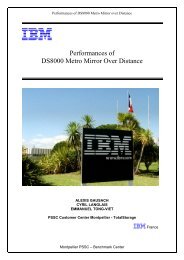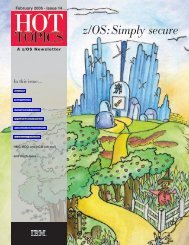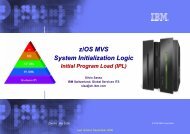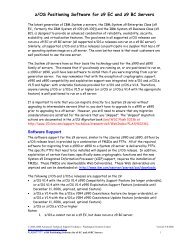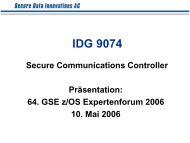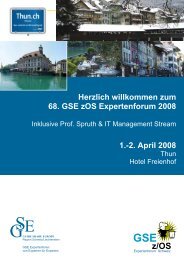Xcf Performance Considerations - Messmer The Brain House
Xcf Performance Considerations - Messmer The Brain House
Xcf Performance Considerations - Messmer The Brain House
Create successful ePaper yourself
Turn your PDF publications into a flip-book with our unique Google optimized e-Paper software.
<strong>The</strong> parameter GROUP(UNDESIG) specifies the messages should be assigned to the transport<br />
class based solely on message size. This definition makes all the resources available to all users<br />
and provides everyone with peak capacity.<br />
<strong>The</strong>re may be times when you want a separate transport class for a specific group. For instance,<br />
if you have a particular XCF user which is consuming a disproportionate amount of XCF<br />
resources, you may want to isolate this user to a separate transport class to investigate the user’s<br />
behavior and protect the other XCF users. Hopefully, after you have diagnosed the problem, you<br />
can reassign this user to a transport class based on the length of the messages. XCF can<br />
dynamically add and delete transport classes by using the SETXCF command.<br />
You can use an RMF XCF report to determine how well the messages fit:<br />
XCF USAGE BY SYSTEM<br />
-----------------------------------------------------------------------<br />
REMOTE SYSTEMS<br />
-----------------------------------------------------------------------<br />
OUTBOUND FROM JB0<br />
-----------------------------------------------------------------------<br />
----- BUFFER -----<br />
TO TRANSPORT BUFFER REQ % % % % ....<br />
SYSTEM CLASS LENGTH OUT SML FIT BIG OVR<br />
JA0 DEFLARG 16,316 189 98 1 1 100<br />
DEFAULT 956 55,794 0 100 0 0<br />
JB0 DEFLARG 16,316 176 100 0 0 0<br />
DEFAULT 956 44,156 0 100 0 0<br />
JC0 DEFLARG 16,316 176 100 0 0 0<br />
DEFAULT 956 34,477 0 100 0 0 ....<br />
----------<br />
TOTAL 134,968<br />
%SML is the % of messages smaller than the buffer length<br />
%FIT is the % of messages which fit the buffer length<br />
%BIG is the % of messages larger than the buffer length<br />
In this example, the majority of the messages fit in the DEFAULT class. A few exceeded the size<br />
of the DEFLARG class, but not enough to justify the definition of a new transport class.<br />
Note: XCF has internal buffers of fixed size: 1K, 4K, 8K, ..64K. XCF uses 68 bytes for internal control blocks. So<br />
if you specify a length which doesn't fit one of these sizes, XCF will round up to the next largest size. For example,<br />
if you specify 1024, it will not fit into the 1K block (1024-68=956), and XCF will round up to the next largest<br />
block. If you issue a command, D XCF,CLASSDEF, it will list the CLASSLEN specified in the PARMLIB<br />
member, in this example, 1024. <strong>The</strong> RMF XCF report will show the actual buffer length, in this case 4028.<br />
© 2001, 2006, IBM Corporation, zSeries <strong>Performance</strong> Version Date: 3/30/2006<br />
http://www.ibm.com/support/techdocs Page 3<br />
XCF <strong>Performance</strong> <strong>Considerations</strong> (V3)


